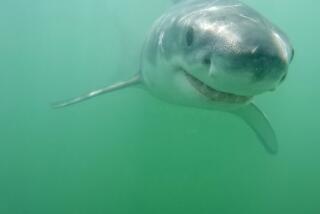A young shark is on quite an adventure
- Share via
The young white shark spent five months at the Monterey Bay Aquarium, in a million-gallon exhibit that was beginning to feel like a fish bowl.
So he became antsy and began to jump, as if to beg his handlers for freedom, and like mother birds they delivered him offshore and punted him from the nest.
Smartly, the junior apex predator chose a southbound journey toward warmer climes; he swam beyond Southern California deep into Mexico.
His is a realm without borders; he requires no passport.
Nor does he need a parent or guardian; though young, he possesses white shark instincts honed over millions of years.
But he is young, and still small.
He measured only 5 feet 10 and weighed 140 pounds when set free Feb. 5, wearing high-tech tags that may allow scientists to shadow him through much of the summer.
Years from now, if he can avoid serious trouble, he’ll attain a great white size of perhaps 18 feet and 4,000 pounds.
Meanwhile, what an incredible adventure life must be. Like the previous white shark released after a lengthy aquarium stay, this one rounded Cabo San Lucas off Baja California’s tip and entered the Sea of Cortez.
But he took a more direct approach and arrived much quicker, and his tags are longer-lived so scientists may learn much more this time around.
“We’re like, ‘Go shark, go!’ ” says Salvador Jorgensen, a researcher with the Tagging of Pacific Pelagics program at Stanford University’s Hopkins Marine Station. “It’s really exciting. But we’re also biting our nails a little bit because he’s just wandering through these heavily fished areas.”
Stanford is the aquarium’s lead partner in the white shark research program. Scientists, with the help of partners at Long Beach State and the Southern California Marine Institute, have learned that Eastern Pacific white sharks spend about three years eating fish in the Southern California bight, or off Baja and maybe in the Sea of Cortez.
After that they begin a new life phase. They develop different teeth, designed to kill elephant seals and other pinnipeds.
They gravitate either to Northern California or Guadalupe Island, 150 miles west of Baja, where they spend late-summer and fall near seal rookeries.
Extensive tagging of adult white sharks at both locations has shown they migrate each winter either to the Hawaiian Islands or a vast and featureless gathering place halfway to Hawaii, referred to as the White Shark Cafe.
It’s not known why but perhaps mating is involved. Nor is it known whether Northern California sharks mingle with Guadalupe sharks, but there’s no evidence of a Northern California shark visiting Guadalupe, or vice-versa.
And, it is not known to which group the juvenile shark now exploring mainland Mexico near Mazatlan will ultimately belong.
But his is an important mission: to help scientists identify critical nursery habitats that “are the key to learning how best to build protection for these animals,” says Barbara Block, principal investigator with the TOPP project.
Because he’s already at the southernmost known range of juvenile white sharks, scientists anticipate he will turn north and begin to explore the Sea of Cortez.
When the archival tag pops free July 2 -- the second tag is a positioning unit with a longer life span -- it’ll reveal the shark’s diving habits and temperature preferences.
(The previous shark ventured 300 miles west upon release and was 700 miles offshore at one point during his southbound journey. He spent daytime near the surface but by night remained at an average depth of 250 feet.)
What tagging studies cannot reveal, however, can only be imagined.
The latest shark took a more coastal route. He bypassed Baja’s large lagoons, where thousands of Pacific gray whales were wintering or embarking on the long journey back to Arctic home waters.
Did he come face-to-face with creatures so large, and what might his reaction have been?
He undoubtedly probed many of the peninsula’s cavernous dark reefs, which are home to territorial groupers with mouths equally cavernous and dark.
At virtually every turn were gargantuan sea lions, curious, powerful and voracious; future items of sustenance but for now something to steer clear of.
As for other sharks, they have hammer-shaped heads and monikers such as Tiger and Bull; hardly your choir-boy types.
But the most serious threat is the same to all swimming creatures of the region: a minefield of invisible gill-nets and baited longline hooks, which have depleted Mexico’s sharks over the years.
This juvenile knows something about indiscriminate fishing gear, though, having been caught in a net off Ventura last summer.
His life was spared when he was donated to the aquarium, and for 162 days he served as ambassador for his species, to more than 650,000 human visitors.
His message was simple: “We’re not savage killers as you may have been led to believe, thanks to sensational movies such as ‘Jaws.’ Rather, we’re vital members of the marine ecosystem, just trying to survive.”
No other shark, it seems, has tried harder.
For more information on the TOPP program or to follow this shark’s progress, visit Topp.org and click on the TOPP Data page.
--


